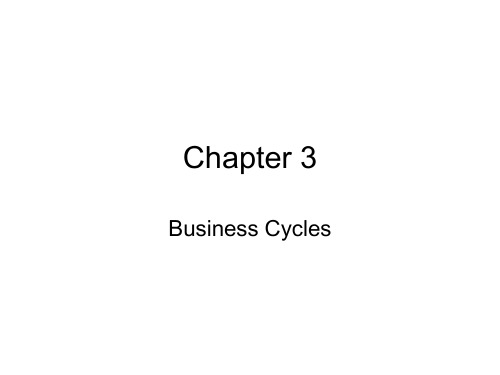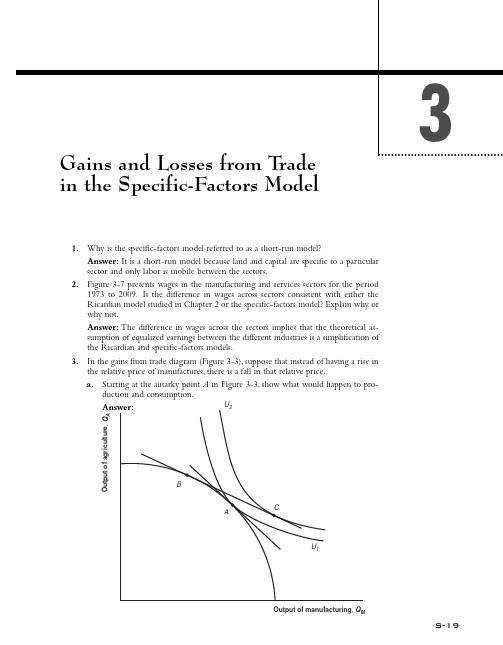ch03Gains and Losses from Trade in the Specific-Factors Model(国际贸易,英文版)
- 格式:ppt
- 大小:2.30 MB
- 文档页数:46
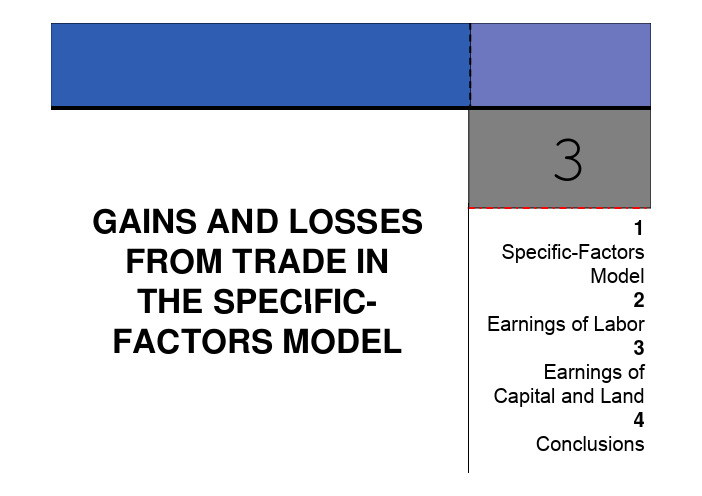

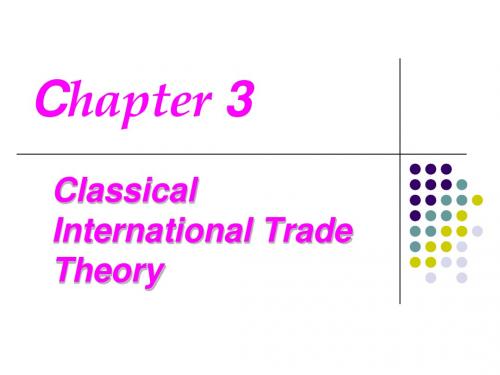
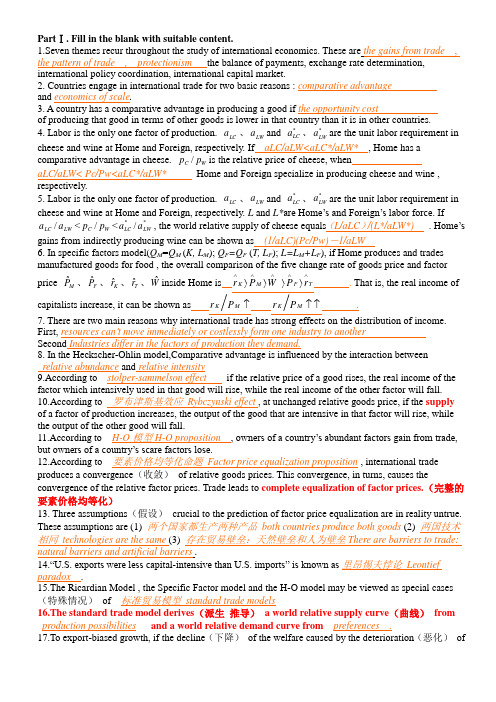
Part Ⅰ. Fill in the blank with suitable content.1.Seven themes recur throughout the study of international economics. These are the gains from trade , the pattern of trade , protectionism the balance of payments, exchange rate determination, international policy coordination, international capital market.2. Countries engage in international trade for two basic reasons : comparative advantage and economics of scale .3. A country has a comparative advantage in producing a good if the opportunity cost of producing that good in terms of other goods is lower in that country than it is in other countries.4. Labor is the only one factor of production. LC a 、LW a and *LC a 、*LW a are the unit labor requirement in cheese and wine at Home and Foreign, respectively. If aLC/aLW<aLC*/aLW* , Home has a comparative advantage in cheese. C p /W p is the relative price of cheese, whenaLC/aLW< Pc/Pw<aLC*/aLW* Home and Foreign specialize in producing cheese and wine , respectively.5. Labor is the only one factor of production. LC a 、LW a and *LC a 、*LW a are the unit labor requirement in cheese and wine at Home and Foreign, respectively. L and L*are Home’s and Foreign’s labor force. IfLC a /LW a <C p /W p <*LC a /*LW a , the world relative supply of cheese equals (L/aLC )/(L*/aLW*) . Home’s gains from indirectly producing wine can be shown as (1/aLC)(Pc/Pw)-1/aLW6. In specific factors model(Q M =Q M (K, L M ); Q F =Q F (T, L F ); L=L M +L F ), if Home produces and trades manufactured goods for food , the overall comparison of the five change rate of goods price and factorprice MP ˆ、F P ˆ、K r ˆ、T r ˆ、W ˆinside Home is T F M K r P W P r ∧∧∧∧∧〉〉〉〉 . That is, the real income ofcapitalists increase, it can be shown as K r .7. There are two main reasons why international trade has strong effects on the distribution of income.First, resources can ’t move immediately or costlessly form one industry to another Second Industries differ in the factors of production they demand.8. In the Heckscher-Ohlin model,Comparative advantage is influenced by the interaction between relative abundance and relative intensity9.According to stolper-sammelson effect if the relative price of a good rises, the real income of the factor which intensively used in that good will rise, while the real income of the other factor will fall. 10.According to 罗布津斯基效应 Rybczynski effect , at unchanged relative goods price, if the supply of a factor of production increases, the output of the good that are intensive in that factor will rise, while the output of the other good will fall.11.According to H-O 模型H-O proposition , owners of a country’s abundant factors gain from trade, but owners of a country’s scare factors lose.12.According to 要素价格均等化命题 Factor price equalization proposition , international trade produces a convergence (收敛) of relative goods prices. This convergence, in turns, causes theconvergence of the relative factor prices. Trade leads to complete equalization of factor prices.(完整的要素价格均等化)13. Three assumptions (假设) crucial to the prediction of factor price equalization are in reality untrue. These assumptions are (1) 两个国家都生产两种产品 both countries produce both goods (2) 两国技术相同 technologies are the same (3) 存在贸易壁垒:天然壁垒和人为壁垒There are barriers to trade: natural barriers and artificial barriers .14.“U.S. exports were less capit al-intensive than U.S. imports” is known as 里昂惕夫悖论 Leontief paradox .15.The Ricardian Model , the Specific Factor model and the H-O model may be viewed as special cases (特殊情况) of 标准贸易模型 standard trade models16.The standard trade model derives (派生 推导) a world relative supply curve (曲线) from production possibilities and a world relative demand curve from preferences .17.To export-biased growth, if the decline (下降) of the welfare caused by the deterioration (恶化) ofthe terms of trade swap over (交换) the rise of the welfare caused by growth, the growth is immiserizing growth (贫困化增长).18. Some economists argued that export-biased growth by poor nations would worsen their term of trade so much that they would be worse off than if they had not grown at all. This situation is known as immiserizing growth (贫困化增长) .19.Immiserizing growth demands strict conditions, these conditions are economic growth is strongly export-biased , the growing country is large enough to affect the world price , RS and RD must be very steep .20.According to “ 梅茨勒悖论Metzle paradox ”, t ariffs and export subsidies (补贴) might have perverse (有害的) effects on internal price. 21.In the model of “Monopolistic (垄断) Competition and Trade”, firms of an individual nation face the trade-off between economies of scale and variety of products .22. Marshall argued that there were three main reasons why a cluster of firms (企业集群)may be more efficient than an individual firm in isolation: specialized supplies , labor market pooling , knowledge spillovers (知识溢出)23.The pattern of intraindustry (产业内) trade itself is unpredicted, history and accident determine the details of the trade pattern.39. When there is external economies (外部经济), the pattern of international trade is determined by economics of scale interact with comparative advantage .24. The indexes (指标)of intrainindustry trade of a industry can be calculated by the standard formula:25. Interindustry trade and intrainindustry (产业内) trade are the sources of gains from trade . When countries are similar in their relative factor supplies 、scale economies and product differentiations are important , intrainindustry trade is the dominant source (主要来源) of gains from trade, everyone gains from trade.26.The argument of temporary (暂时的) protection of industries to enable them to gain experience is known as 幼稚产业论the infant industry argument27. If we add together the gains and losses from a tariff, We find the net effect on national welfarecan be separated into two parts: terms of trade gain and efficiency loss 28.Why do countries adopt trade policies such as tariff or import quota, which produce more costs than benefits?—— trade politics29.In the political economy of trade policy (贸易政策的政治经济学) , government are assumed to (被假定为)maximize 政治成功political success rather than 国家福利 national welfare . 30.Deviations from free trade can sometimes increase national welfare. These arguments include the term of trade argument for a tariff and the domestic market failure argument31.According to “Specific rule (对症规则) ”, domestic market failure should be corrected by domestic policies aimed directly at the problem’s sources.32. Although market failures are probably common, the domestic market failure argument against free trade should not be applied too freely.First domestic market failure should be corrected by domestic policies aimed directly at the problems ’ sources ;Second economists cannot diagnose market failure well enough to prescribe policy .33. International trade often produces losers as well as winners. In the actual politics of trade policy,income distribution is of crucial importance. 集体行动问题The problem of collective action can explain why policies that not only seem to produce more costs than benefits but that also seem to hurt far more voters them they can help can nonetheless be adopted.34.The WTO includes four aspects content: GATT 1994, GATS , TRIPS , TRIMS35.“Nondiscriminatory” principles (非歧视性原则)include most favored nation principle and national treatment principle36.For preferential (优惠) trading agreements, such as customs union , countries must cede part ofexp 1exp orts importsI orts imports -=-+their sovereignty to supranational entity (必须放弃部分主权的超国家实体) 37.Whether a customs union (关税同盟) is desirable (可取) or undesirable depends on whether it largelyindustrialization and coping with the problems of the dual economy. Correspondingly, there are two main arguments for developing countries to pursue policy of import-substituting industrialization. The two arguments are the infant industry argument t and market failure justification for infant industry protection .40. Sophisticated proponents of the infant industry argument have identified two market failures as reasons why infant industry protection may be a good idea: The imperfect capital markets justification and The appropriability argument .Part Ⅱ. True or False (true and false are denoted by “T” and “F”, respectively) 1. If a LW */a L C *<a LW /a L C , Home’s relat ive productivity in cheese is higher. (T )2. According to the Ricardian model, it is precisely because the relative wage is between the relative productivities that each country ends up with a cost advantage in one good.The good for which *Li a /Li a >w /*w will be produced in Foreign. ( F )3. It is precisely because the relative wage is between the relative productivities that each country ends up with a cost advantage in one good. ( T )4.Long-run convergence(长期收敛) in productivity (生产力)produces long-run convergence in wages.( T )5. “Korean workers earn only $2.50 an hour; if we allow Korea to export as much as it likes to the United States, our workers will be forced down to the same level. You can’t import a $5 shirt without importing the $2.50 wage that goes with it.” (F )6.The proposition that trade is beneficial is unqualified(不合格). That is, there is no requirement that a country be “competitive” or that the trade be “fair”. ( T)7. Free trade is beneficial only if your country is strong enough to stand up to foreign competition. ( F ) 8. Foreign competition is unfair and hurts other countries when it is based on low wages. (F ) 9. Trade exploits a country and make it worse off if its workers receive much lower wage than workers in other nations. (F )10.The Ricardian Model predicts an extreme degree(预测一个极端的程度) of specialization(专业化). ( T )11.The Ricardian Model neglects(忽略) the effects on income distribution. (T )12. The basic prediction of the Ricardian model has been strongly confirmed by a number of studies over years. ( T )13. The Ricardian Model predicts that countries tend to export those goods in which their productivity is relative high. ( T )14. We can think of factor specificity as a matter of time. ( T )15.The opportunity cost of manufacture in terms of food is denoted by(表示) MPL M /MPL F . ( F ) 16.A equal proportional change in price have no real effects on the real wage, real income of capital owner and land owner. ( T )17. Trade benefits the factor that is specific to the import-competing sectors of each country but hurts the factor to the export sectors, with ambiguous effects on mobile factors. ( F )18.It is possible in principle for a country’s government to use taxes and subsidies (补贴) to redistribute (重新分配) income to give each individual more of both goods. ( T )19. Although international trade has strong effects on income distribution, there are still possible in principle to make each individual better off. ( T )20. Typically, those who gain from trade in any particular product are a much more concentrated, informed, and organized group than those who lose. ( F )21. Conflicts of interest(利益冲突) within nations are usually more important in determining trade policythan conflicts of interest between nations. ( T )22. Generally, economists do not regard the income distribution effects of trade as a good reason to limit trade. ( T )23.The formulation of trade policy(贸易政策的制定) is a kind of political process(政治进程). ( T )24. “The world’s poorest countries can’t find anything to export. There is no resource that i s abundant—certainly not capital or land, and in small poor nations not even labor is abundant.” ( F )25. Wage inequality in U.S. increased between the late 1970s and the early 1990s, economists attribute the change to the growing exports of manufactured goods from NIEs. ( T )26. If the factor-proportion theory was right, a country would always export factors for which the income share exceeded the factor share, import factors for which it was less. ( F )27.The H-O model can predict not only the direction but the volume of trade(贸易量). ( T )28.Factor trade in general turns out to be much smaller than the H-O model predicts. ( T )29. According to an influential recent paper, the H-O model can predict not only the direction but the volume of trade. Factor trade in general turn out to be t he same a s the H-O model predicts. ( F )30. Only by dropping the Heckscher-Ohlin assumption that technologies are the same across the countries can the overall pattern of international trade be well predicted by the H-O model. ( T )31.If a country want to maximize its national welfare, the consumption point is where the highest isovalue line is tangent to the highest reachable indifference curve. ( T )32.A rise in the terms of trade increases a country’s welfare, while a decline in the terms of trade reduces its welfare. ( T )33.Export-biased growth tends to improve the growing country’s terms of trade at the rest of the world’s expense.( F )34.If the two countries allocate(分配) their change in spending in the same proportions, there will not be a terms of trade effect. ( T )35. If the country receiving a transfer spends a higher proportion of an increase income on its export good than the giver, a transfer raises world relative demand for the recipient’s export good and thus improve it s terms of trade. ( T )36.A transfer worsens the donor’s terms of trade if the donor has a higher mariginal propensity to spend on its export good than the recipient(受体). ( T )37.A transfer improves the donor’s terms of trade, worsens recipient’s terms of tra de. ( F )38.A transfer of income——say foreign aid——could conceivably leave the recipient worse off. ( T )39.A tariff improves Home’s terms of trade and worsens Foreign’s, while a Home export subsidy worsens Home’s terms of trade and improve Foreign’s.( T )40. Where there is economies of scale, there is imperfectly competitive market structure. ( F )41.If intraindustry trade is the dominant source of gains from trade, everyone gains from trade. ( T )42.Effect on the distribution of income within countries often weight more heavily on policy than terms of trade concerns. ( T )43.The usual market structure in industries characterized by internal economies of scale is monopolistic competition. ( F )44.Today, antidumping(反倾销) may be a device of protectionism. ( T )45.Reciprocal(相互) dumping tends to increase the volume of trade in goods that are quite identical (一致). ( F )46.It is possible that reciprocal dumping increase national welfare. ( T )47.Strong external(外部) economies te nd to “locked in” the existing patterns of interindustry trade, even if the patterns are run counter to(背道而驰) comparative advantage. ( T )48.A trading country can conceivably lose from trade is potentially justify protectionism. ( T )49.Like static external economies, dynamic external economies can lock in an initial advantage in an industry. ( T )50.The stratigic trade policy is related to the model of “Monopolistic competition, differentiate product s and intraindustry trade”. ( F )51.The model “Oligopoly, homogeneous products and intraindustry trade” is first developed by Krugman and Helpman . ( F )52.Trade in factors is very much like trade in goods, it occurs for much the same reasons and producessimilar results. ( T )53.Trade in factors is an alternative(替代) to trade in goods for the allocation of resources. ( T )54.Wh en a country borrows, it’s intertemporal PPF is biased toward Q P.( F )55.The relative price of future consumption goods Q P is (1+r). ( T )56.The dynamic path of TNC s’ enter foreign market:FDI→Export→Licence. (F )57.Tariffs may have very different effects on different stages of production of a good. ( T )58.Nominal(名义)tariff reflects the effective rate of protection(有效保护率). (F)59.The costs and benefits analysis of a tariff is correct if only the direct gains to producers and consumers in a given market accurately measure the social gains. ( T )60.The costs and benefits analysis of a tariff is correct if only a dollar’s worth of benefits to each group is the same. ( T )61.A VER is exactly like an import quota which the license are assigned to foreign government. ( T )62.VER S are much more costly than tariffs. ( T )63.Local content laws have been widely used by developing countries trying to shift their manufacturing from assembly back into intermediate goods. ( T )64. A political argument for free trade reflects the fact that a political commitment to free trade may be a good idea in practice even though there may be better policies in principle. ( T )65.Deviations from free trade can sometimes increase national welfare. (T )66.For a sufficiently small tariff the terms of trade gain of small country must outweigh the efficiency loss.( F )67.The domestic market failure argument against free trade is intellectually impeccable but of doubtful usefulness. (F )68. “U.S. farm exports don’t just mean hi gher incomes for farmers — they mean higher income for everyone who sell goods and services to the U.S. farm sector”. This remark is a potential valid a rgument for export subsidy. ( T )69.Most deviations from free trade are adopted not because their benefit exceed their costs but because the public fails to understand their true costs. ( T )70.If there is marginal social costs rather than marginal social benefits, domestic market failure reinforce the case for free trade. ( T )71.The electoral competition model believes political competition will drive both parties to propose tariffs close to t M, the tariff preferred by the medium voter. ( T )72.The problem of collective action can best be overcome when a group is large and/or well organized. (F )73.Trade policy that produce more costs than benefits, hurt more consumers than producers can’t be adopted.( F )74. As a violation of the MFN(“most favored nation”) principle, the WTO forbids preferent ial trading agreements in general, but allows them if they lead to free trade between the agreeing countries. ( T )75.The infant industry argument violates (违背)the principle of comparative advantage ( T )76.Import substituting industrialization(进口替代工业化) violates the principle of comparative advantage.( T )77. “Import quotas on capital-intensive industrial goods and subsidies for the import of capital equipment were meant to create manufacturing jobs in many developing countries. Unfortunately, they have probably helped create the urban unemployment problem.” ( T )78.The East Asian Miracle proved that industrialization and development must be based on import substitution. ( F )79.It is impossible for country to make itself worse off by joining accustoms union(联盟). ( F )PartⅢ. Choose the ONLY one collect answer in each question.1. An important insight(启示)of international trade theory is that when countries exchange goods and services one with the other itA.is always beneficial to both countries.B.is usually beneficial to both countries.C.is typically beneficial only to the low wage trade partner country .D.is typically harmful to the technologically lagging country.E.tends to create unemployment in both countries.2. If there are large disparities(差距)in wage levels between countries, thenA. trade is likely to be harmful to both countries.B. trade is likely to be harmful to the country with the high wages.C. trade is likely to be harmful to the country with the low wages.D. trade is likely to be harmful to neither country.E. trade is likely to have no effect on either country.3.Cost-benefit analysis of international trade(成本收益分析)A.is basically useless.B.is empirically intractable.C.focuses attention on conflicts of interest within countries.D.focuses attention on conflicts of interests between countries.E.None of the above.4. A primary reason why nations conduct international trade is because of differences inA.historical perspective.B.location.C.resource availabilities.D.tastes.E.incomes.5. Arguments for free trade are sometimes disregarded(忽视)by the political process becauseA.economists tend to favor highly protected domestic markets.B.economists have a universally accepted decisive power over the political decision mechanism.C.maximizing consumer welfare may not be a chief priority(优先)for politicians. 扩大消费者福利不是最主要的D.the gains of trade are of paramount concern to typical consumers.E.None of the above.6.Proponents(支持)of free trade claim all of the following as advantages except__A. relatively high wage levels for all domestic workers.B. a wider selection of products for consumersC. increased competition for world producers.D. the utilization of the most efficient production processes.E. None of the above.In order to know whether a country has a comparative advantage in the production of one particular product we need information on at least ____unit labor requirementsA.oneB.twoC.threeD fourE five7. A country engaging in trade according to the principles of comparative advantage gains from trade because itD.is producing exports indirectly more efficiently than it could alternatively.E.is producing imports indirectly more efficiently than it could domestically.F.is producing exports using fewer labor units.G.is producing imports indirectly using fewer labor units.H.None of the above.8. A nation engaging in trade according to the Ricardian model will find its consumption bundle (消费约束)A.inside its production possibilities frontier.B.on its production possibilities frontier.C.outside its production possibilities frontier (生产可能性边界).D.inside its trade-partner's production possibilities frontier.E.on its trade-partner's production possibilities frontier.9.If a very small country trades with a very large country according to the Ricardian model, thenA.the small country will suffer a decrease in economic welfare.B.the large country will suffer a decrease in economic welfare.C.the small country will enjoy gains from trade.D.the large country will enjoy gains from trade.E.None of the above.10.If the world terms of trade for a country are somewhere between the domestic cost ratio of H and that of F, thenA.country H but not country F will gain from trade.B.country H and country F will both gain from trade.C.neither country H nor F will gain from trade.D.only the country whose government subsidizes its exports will gain.E.None of the above.11.If a production possibilities frontier is bowed out (concave to the origin) )(上凸,凹面向原点), then production occurs under conditions ofA.constant opportunity costs.B.increasing opportunity costs.C.decreasing opportunity costs.D.infinite opportunity costs.E.None of the above.12.If two countries have identical production possibility frontiers, then trade between them is not likely ifA.their supply curves are identical.B.their cost functions are identical.C.their demand conditions identical.D.their incomes are identical.E.None of the above.13.Assume that labor is the only factor of production and that wages in the United States equal $20 per hour while wages in Japan are $10 per hour. Production costs would be lower in the United States as compared to Japan ifA.U.S. labor productivity equaled 40 units per hour and Japan's 15 units per hour.B.U.S. productivity equaled 30 units per hour whereas Japan's was 20.C.U.S. labor productivity equaled 20 and Japan's 30.D.U.S. labor productivity equaled 15 and Japan's 25 units per hour.E.None of the above.14.International trade has strong effects on income distributions. Therefore, international trade A.is beneficial to everyone in both trading countries.B.will tend to hurt one trading country.C.will tend to hurt some groups in each trading country.D.will tend to hurt everyone in both countries.E.will be beneficial to all those engaged in international trade.15.If the price of the capital intensive product rises, wages willA.rise but by less than the price of the capital-intensive product.(工资刚性,变动较慢)B.rise by more than the rise in the price of the capital-intensive product.C.remain proportionally equal to the price of the capital-intensive product.D.fall, since higher prices cause less demand.E.None of the above.16.If Australia has more land per worker, and Belgium has more capital per worker, then if trade were to open up between these two countries,A.the real income of capital owners in Australia would rise.B.the real income of labor in Australia would clearly rise.C.the real income of labor in Belgium would clearly rise.D.the real income of landowners in Belgium would fall. 贸易知识使一国丰富要素部门得利,稀缺要素部门受损)E.the real incomes of capital owners in both countries would rise.17.If the price of manufactures and the price of food increase by 25%, thenA.the economy moves down its aggregate supply curve.B.the economy moves back along its aggregate demand curve.C.the relative quantities(相对数量)of manufactures and food remain unchanged.D.the relative quantities of products change by 25%.E.None of the above.18.If the price of manufactures rises, thenA.the price of food also rises.B.the quantity of food produced falls.C.the quantity of both manufactures and food falls.D.the purchasing power of labor in terms of food falls.E.None of the above.18.Groups that lose from trade tend to lobby(游说)the government to(贸易失利者游说政府)A.shift the direction of comparative advantage.B.abolish the Specific Factor model from practical application.C.provide public support for the relatively efficient sectors.D.provide protection for the relatively inefficient sectors.E.None of the above.19.The specific factor model argues that if land can be used both for food production and for manufacturing, then a quota that protects food production willA.clearly help landowners.B.clearly hurt landowners.C.clearly help manufacture but hurt food production.D.have an ambiguous effect on the welfare of landowners.E.None of the above.20.If, relative to its trade partners, Gambinia has many workers but very little land and even less productive capital, then, following the specific factor model, we know that Gambinia has a comparative advantage inA.manufactures.B.food.C.both manufactures and food.D.neither manufactures nor food.E.None of the above.21.In the 2-factor, 2 good Heckscher-Ohlin model, an influx of workers from across the border would(劳动者越过国境流入)A.move the point of production along the production possibility curve.B.shift the production possibility curve outward, and increase the production of both goods.C.shift the production possibility curve outward and decrease the production of thelabor-intensive product.D.shift the production possibility curve下降,扩展了生产可能性曲线,相当于扩展了消费的总量)E.None of the above.22.The 1987 study by Bowen, Leamer and SveikauskasA.supported the validity of the Leontieff Paradox.B.supported the validity of theHeckscher-Ohlin model.ed a two-country and two-product framework.D.demonstrated that in fact countries tend to use different technologies.E.proved that the U.S.'s comparative advantage relied on skilled labor.23.The Case of the Missing Trade refers toA.the 9th volume of the Hardy Boys' Mystery series.B.the fact that world exports does not equal world imports.C.the fact that factor trade is less than predicted by the Heckscher-Ohlin theory.D.the fact that the Heckscher Ohlin theory predicts much less volume of trade than actually exists.E.None of the above.24.One way in which the Heckscher-Ohlin model differs from the Ricardo model of comparative advantage is by assuming that _技术相同__ is (are) identical in all countries.A.factor of production endowmentsB.scale economiesC.factor of production intensitiesD.technologyE.opportunity costs25.As opposed to the Ricardian model of comparative advantage, the assumption of diminishing returns in the Heckscher-Ohlin model means that the probability is greater that with trade A.countries will not be fully specialized(专业化)in one product.B.countries will benefit from free international trade.C.countries will consume outside their production possibility frontier.parative advantage is primarily supply related.E.None of the above.26.Suppose that there are two factors, capital and land, and that the United States is relatively land endowed while the European Union is relatively capital-endowed. According to the Heckscher-Ohlin model,A.European landowners should supportUS-European free trade.B.European capitalists should supportUS-European free trade.C.all capitalists in both countries should support free trade.D.all landowners should support free trade.E.None of the above.27.According to the Heckscher-Ohlin model, if the United State s is richly endowed inhuman-capital relative to Mexico, then as NAFTA increasingly leads to more bilateral free trade between the two countries,A.the United States will find its industrial base sucked into Mexico.B.Mexico will find its relatively highly skilled workers drawn to the United States.C.The wages of highly skilled U.S. workers will be drawn down to Mexican levels.D.The wages of highly skilled Mexican workers will rise to those in the United States.E.The wages of highly skilled Mexican workers will fall to those in the United States. (墨西哥高技术工人工资降低到美国同水平)28.If two countries were very different in their relative factor availabilities(相对要素丰富程度相差很多), then we would not expect which of the following to be empirically supported?。
